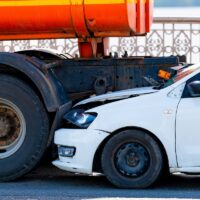Rear-End Collisions: Is the Rear Driver Always at Fault?

By most accounts, rear-end collisions are the most common type of car accidents in Texas and across the United States. Although rear-end crashes aren’t always severe, they do often cause significant property damage, and serious injuries occur probably more often than you think. A widespread belief is that the rear driver is always at fault in rear-end collisions. However, while the rear driver is frequently responsible, there are exceptions to this rule. It’s always important to work with an experienced car accident lawyer when you’ve been injured in a crash. Whether you were rear-ended or hurt in the following car, questions of liability can lower your recovery or take away your claim altogether.
Read on for a discussion of liability in rear-end collisions, including the many situations when the driver in the back might not be responsible. For help after a car accident injury in Texas, contact McLemore, Reddell, & Story, P.L.L.C., to speak with an experienced and successful Houston personal injury lawyer.
The Presumption of Fault
In rear-end collisions, there is a general presumption that the rear driver is at fault. This assumption is based on the principle that drivers should maintain a safe following distance to avoid accidents, even in the event of sudden stops by the vehicle ahead. Texas law stipulates that a driver should not follow another vehicle more closely than is reasonable and prudent, considering the speed of the vehicles and the traffic conditions.
While the rear driver is often presumed to be at fault, there are several scenarios where this may not be the case:
Sudden and Unjustified Stops
If the front driver makes a sudden and unexpected stop without a valid reason, they may share or even bear the fault for the collision. For instance, if a driver slams on the brakes in the middle of the road out of rage or without any valid traffic or safety reason, this behavior could be deemed negligent.
Faulty Brake Lights
If the front vehicle’s brake lights are not functioning correctly, the rear driver might not have adequate warning to stop in time. In such cases, the faulty brake lights can shift some or all of the fault to the front driver.
Unsafe Lane Changes
If a vehicle ahead abruptly changes lanes and cuts in front of another car without leaving enough space, the resulting rear-end collision may be attributed to the driver who made the unsafe lane change. Texas law requires drivers to signal lane changes and ensure it is safe to merge before moving into another lane.
Multi-Vehicle Pileups
In multi-vehicle accidents, determining fault can be more complex. An initial collision may set off a chain reaction of rear-end crashes. In such scenarios, the fault may be distributed among multiple drivers depending on their actions and the circumstances leading up to the accident.
Gathering Evidence
Proving fault in a rear-end collision requires thorough investigation and gathering of evidence. Some of the key pieces of evidence include:
-
Police Reports. Police reports often contain crucial information about the accident scene, witness statements, and any traffic violations. These reports can provide an objective account of the incident.
-
Eyewitness Testimony. Eyewitnesses can offer valuable perspectives on how the accident occurred. Their testimonies can help establish whether the front driver made a sudden stop or if there were other contributing factors.
-
Traffic Camera Footage. Footage from traffic cameras or nearby surveillance systems can offer clear evidence of the events leading up to the collision. This visual evidence can be instrumental in determining fault.
-
Vehicle Damage Analysis. The damage patterns on the vehicles involved can provide insights into the nature of the collision. For instance, if the front car has minimal damage while the rear car is significantly damaged, it may indicate that the front driver was not moving when struck.
The Importance of Legal Assistance
Navigating the complexities of fault in rear-end collisions can be challenging, and it is essential to consult with an experienced personal injury attorney who can help gather evidence, analyze the circumstances, and build a strong case for compensation. For instance, if both parties are deemed partially at fault, the accident victim’s monetary damages will be reduced proportionately, and if they are more than 50% to blame, they cannot recover any compensation under Texas law. At McLemore, Reddell, & Story, P.L.L.C., our dedicated team of personal injury attorneys is committed to representing accident injury victims throughout Texas. We understand the intricacies of rear-end collision cases and are here to ensure that you receive the justice and compensation you deserve.
If you or a loved one has been involved in a rear-end collision in Texas, call McLemore, Reddell, & Story, P.L.L.C. at 713-303-8543 for a free consultation. Our experienced attorneys are here to guide you through the legal process and fight for your rights.
